
Continuous track or tracked treads are a system of vehicle propulsion used in tracked vehicles, running on a continuous band of treads or track plates driven by two or more wheels. The large surface area of the tracks distributes the weight of the vehicle better than steel or rubber tyres on an equivalent vehicle, enabling continuous tracked vehicles to traverse soft ground with less likelihood of becoming stuck due to sinking.

A half-track is a civilian or military vehicle with regular wheels at the front for steering and continuous tracks at the back to propel the vehicle and carry most of the load. The purpose of this combination is to produce a vehicle with the cross-country capabilities of a tank and the handling of a wheeled vehicle.
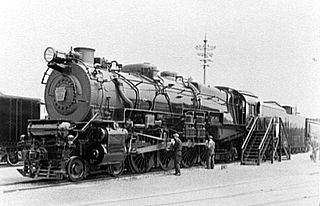
The M1 was a class of steam locomotive of the Pennsylvania Railroad (PRR). It was a class of heavy mixed-traffic locomotives of the 4-8-2 "Mountain" arrangement, which uses four pairs of driving wheels with a four-wheel guiding truck in front for stability at speed and a two-wheel trailing truck to support the large firebox needed for sustained power. Although built for both passenger and freight work, they spent most of their service lives hauling heavy high-speed freight trains. Many PRR men counted the M1 class locomotives as the best steam locomotives the railroad ever owned.

A camelback locomotive is a type of steam locomotive with the driving cab placed in the middle, astride the boiler. Camelbacks were fitted with wide fireboxes which would have severely restricted driver visibility from the normal cab location at the rear.

The International Railway of Maine was a historic railroad constructed by the Canadian Pacific Railway (CPR) between Lac-Mégantic, Quebec, and Mattawamkeag, Maine, closing a key gap in the railway's transcontinental main line to the port of Saint John, New Brunswick.

The Monson Railroad was a 2 ft narrow gauge railway, which operated between Monson Junction on the Bangor and Aroostook Railroad and Monson, Maine. The primary purpose of this railroad was to serve several slate mines and finishing houses in Monson. According to the Scientific American of 17 May 1890, it was the smallest railroad in the United States.
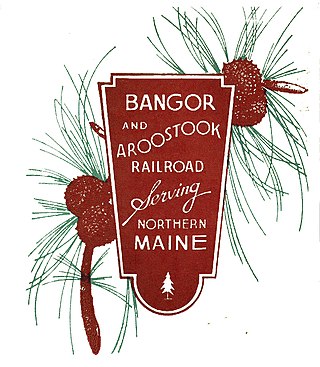
The Bangor and Aroostook Railroad was a United States railroad company that brought rail service to Aroostook County in northern Maine. Brightly-painted BAR boxcars attracted national attention in the 1950s. First-generation diesel locomotives operated on BAR until they were museum pieces. The economic downturn of the 1980s, coupled with the departure of heavy industry from northern Maine, forced the railroad to seek a buyer and end operations in 2003. It was succeeded by the Montreal, Maine and Atlantic Railway.

A steam donkey or donkey engine is a steam-powered winch once widely used in logging, mining, maritime, and other industrial applications.
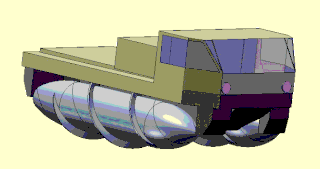
A screw-propelled vehicle is a land or amphibious vehicle designed to cope with difficult terrain, such as snow, ice, mud, and swamp. Such vehicles are distinguished by being moved by the rotation of one or more auger-like cylinders fitted with a helical flange that engages with the medium through or over which the vehicle is moving. They have been called Archimedes screw vehicles by the US military, where they are classified as a type of marginal terrain vehicle (MTV). Modern vehicles called Amphirols and other similar vehicles have specialised uses.

The North Maine Woods is the northern geographic area of the state of Maine in the United States. The thinly populated region is overseen by a combination of private individual and private industrial owners and state government agencies, and is divided into 155 unincorporated townships within the NMW management area. There are no towns or paved roads.

The Linn tractor is a heavy duty civilian half-track or crawler tractor invented by Holman Harry Linn. Approximately 2,500 units were built in Morris, New York, USA from 1916 to 1952.
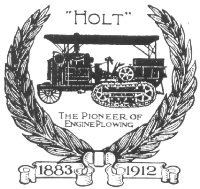
The Holt Manufacturing Company began with the 1883 founding of Stockton Wheel Service in Stockton, California, United States. Benjamin Holt, later credited with patenting the first workable crawler ("caterpillar") tractor design, incorporated the Holt Manufacturing Company in 1892. Holt Manufacturing Company was the first company to successfully manufacture a continuous track tractor By the early 20th century, Holt Manufacturing Company was the leading manufacturer of combine harvesters in the US, and the leading California-based manufacturer of steam traction engines.

The new Belfast and Moosehead Lake Railroad is a subsidiary of the Brooks Preservation Society (BPS), a not-for-profit organization established in 2008 to protect and preserve historic rail transportation infrastructure and assets located within Waldo County, Maine.

Mount Lombard is the highest peak dominating the mountain mass whose southern extremity is Cape Sobral, Graham Land, Antarctica, and surmounting Mundraga Bay to the west. It was mapped from surveys by the Falkland Islands Dependencies Survey (1960–61), and was named by the UK Antarctic Place-Names Committee for American engineer Alvin O. Lombard of the Lombard Steam Log Hauler Company, Waterville, Maine, who designed some of the earliest successful over-snow tractors, the first application of knowledge of snow mechanics to trafficability, 1901–13.

Alvin Orlando Lombard (1856-1937) was the American inventor of the track-wheeled vehicle. First patented in 1901, the Lombard Steam Log Hauler revolutionized the movement of harvested logs through the woods and set the stage for every snowmobile, tank and bulldozer ever built.
The Gull was an international passenger train service between Boston, United States, and Halifax, Canada, which operated from 1930 to 1960. Journey time was approximately 24 hours. Westbound trains left Halifax shortly after breakfast and crossed the Canada–United States border in the late evening, as eastbound trains were leaving Boston's North Station to cross the border about dawn. Travel was over the Boston and Maine Railroad from Boston to Portland, Maine, then over the Maine Central Railroad to the border between Vanceboro, Maine, and Saint Croix, New Brunswick, then over the Canadian Pacific Railway to Saint John, New Brunswick, and over the Canadian National Railway to Halifax.

New York Central and Hudson River Railroad No. 999 is a 4-4-0 “American” type steam locomotive built for the New York Central and Hudson River Railroad in 1893, which was intended to haul the road's Empire State Express train service. It was built for high speed and is allegedly among the first steam locomotives in the world to travel over 100 mph.

The Eagle Lake and West Branch Railroad was a forest railway built to transfer pulpwood between drainage basins in the Maine North Woods. The railroad operated only a few years in a location so remote the steam locomotives were never scrapped and remain exposed to the elements at the site of the Eagle Lake Tramway. Its tracks were located in Penobscot County and Piscataquis County.
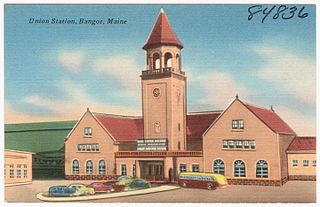
Bangor Union Station was a passenger train station in Bangor, Maine. Long the state's second-largest railroad station, it was served by the Maine Central Railroad and the Bangor and Aroostook Railroad. In 1961, the railroads ended service to the station, which was then demolished to avoid an annual property tax of $10,788 on an assessed valuation of $372,000.






















